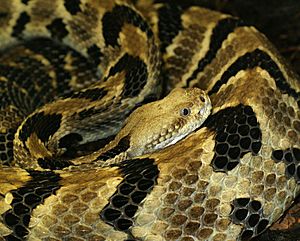Crotalus facts for kids
Quick facts for kids Crotalus |
|
|---|---|
 |
|
| A timber rattlesnake (Crotalus horridus), is a species of Crotalus | |
| Scientific classification | |
| Kingdom: | |
| Phylum: | |
| Subphylum: | |
| Class: | |
| Order: | |
| Suborder: | |
| Family: | |
| Subfamily: | |
| Genus: |
Crotalus
|
Crotalus is a genus of venomous pit vipers found only in the Americas from southern Canada to northern Argentina. The name comes from the Greek word krotalon, which means "rattle", referring to the rattle on the end of the tail. There are currently 29 species recognized.
Description
Members of this genus range in size from only 50–60 cm to over 150 cm. Adult males are slightly larger than females. Compared to most snakes they are heavy-bodied, although some African vipers are much thicker. They are recognized by the rattle on their tail though some species do not have tails.
Feeding
Small species eat mainly lizards, while larger species first eat lizards when young, then start eating mammals when they become adults, like rabbits, squirrels, chipmunks, gophers, rats and mice, some also eat birds, other snakes and amphibians.
Predators
Humans are a threat to Crotalus, but other snakes like the Kingsnake, the Coachwhip, the Indigo Snake and the Racer are also threats. Birds like the hawk, the eagle, the owl, the raven and the roadrunner, and mammals like the coyote, the fox, the wildcat, the badger and the skunk are also threats
Venom
Almost all Crotalus venoms are hemotoxic, meaning that the venom destroys red blood cells, stops blood clotting,and damages tissue. Hemotoxic is very painful, and people who are bitten by a snake with hemotoxic don't always make a full recovery. Some species like Crotalus Scutalatus and Crotalus Tigris have a nuerotoxic venom, while neurotoxins are less painful they kill more quicker. Neurotoxins are also found in the venom of Cobras and mambas. The eastern diamondback rattlesnake (Crotalus Adamanteus) in some parts of its range may have a nuerotoxin in their venom as well as a hemotoxins.
Species
- Eastern diamondback rattlesnake, C. adamanteus
- Querétaro dusky rattlesnake, C. aquilus
- Western Diamondback Rattlesnake, C. atrox
- Mexican west coast rattlesnake, C. basiliscus
- Santa Catalina rattlesnake, C. catalinensis
- Sidewinder, C. cerastes
- South American rattlesnake, C. durissus
- Baja California rattlesnake, C. enyo
- Timber rattlesnake, C. horridus
- Mexican small-headed rattlesnake, C. intermedius
- Autlán rattlesnake, C. lannomi
- Rock rattlesnake, C. lepidus
- Speckled rattlesnake, C. mitchellii
- Black-tailed rattlesnake, C. molossus
- Western rattlesnake, C. oreganus
- Mexican lance-headed rattlesnake, C. polystictus
- Twin-spotted rattlesnake, C. pricei
- Tancitaran dusky rattlesnake, C. pusillus
- Red diamond rattlesnake, C. ruber
- Mohave rattlesnake, C. scutulatus
- Middle American rattlesnake, C. simus
- Long-tailed rattlesnake, C. stejnegeri
- Tiger rattlesnake, C. tigris
- Tortuga island diamond rattlesnake, C. tortugensis
- Totonacan rattlesnake, C. totonacus
- Cross-banded mountain rattlesnake, C. transversus
- Mexican dusky rattlesnake, C. triseriatus
- Prairie rattlesnake, C. viridis
- Ridge-nosed rattlesnake, C. willardi
Images for kids
See also
 In Spanish: Serpientes de cascabel para niños
In Spanish: Serpientes de cascabel para niños

